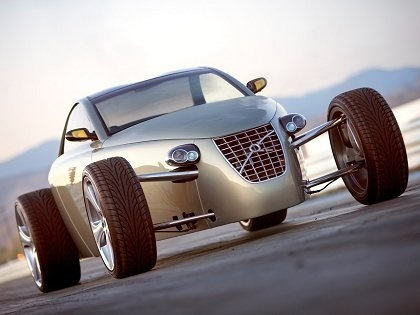2002 Volkswagen 1-Litre Concept
- Story Cars

- Apr 1, 2024
- 3 min read
The 2002 Volkswagen 1-Litre Concept, unveiled on April 16th, 2002, introduced the world to a prototype of the most fuel-efficient car licensed for road use. This innovative vehicle focused on extreme lightweight construction, low fuel consumption, and high safety standards, resulting in a prototype capable of reaching speeds of 120 mph while consuming less than 1 liter of fuel per 100 kilometers.
The development goal of creating a roadworthy vehicle with a fuel consumption of just 1.0 liter per 100 kilometers required meticulous attention to detail and a refusal to compromise on any aspect of design. All existing technical solutions were scrutinized, and in collaboration with numerous suppliers, replaced with lighter and more efficient versions.
The concept of extreme lightweight construction led to the selection of an unusually narrow and flat body form, designed in a wind tunnel and constructed entirely of carbon fiber composites. To further reduce weight, the body was left unpainted, and the carbon-fiber-reinforced outer skin was stretched over a spaceframe made of magnesium.
Powering the 1-Litre Concept is a one-cylinder diesel engine positioned centrally in front of the rear axle and paired with an automated direct shift gearbox. The engine, with a capacity of 0.3 liters, features an aluminum monobloc construction for the crankcase and cylinder head. Despite its small size, the engine generates 6.3 kW (8.5 bhp) at 4,000 rpm, providing the lightweight vehicle, weighing just 290 kg, with lively performance.
The interior of the 1-Litre Concept is sportingly simple yet spacious enough for two occupants, who can easily access the cabin by folding back the turret-like gullwing door. Lightweight construction extends to the seats, with magnesium frames and firm, comfortable fabric covers replacing traditional upholstery.
Safety was a paramount consideration throughout the development of the 1-Litre Concept. Despite its lightweight components, the vehicle incorporates features such as anti-lock brakes, ESP electronic stability program, and a driver's airbag. Deformation elements at the front end and the spaceframe construction provide impact and roll-over protection comparable to that of a GT racing car.
The design of the 1-Litre Concept, with its four wheels, low height, and tandem seating for two, hints at a potential new family of vehicles capable of meeting diverse requirements, from ultra-economical transportation to everyday touring. The prototype was publicly showcased in April 2002 when Ferdinand Piëch, then chairman of the board of management at Volkswagen, drove it between Wolfsburg and Hamburg during the Volkswagen annual meeting of stockholders.
For aerodynamic efficiency, the car seats two occupants in tandem rather than side-by-side and replaces rearview mirrors with cameras and electronic displays. The close positioning of the rear wheels contributes to the streamlined body design, resulting in minimal aerodynamic drag with a drag coefficient (Cd) of 0.159.
The external dimensions of the 1-Litre Concept measure 3.47 m (11.4 ft) in length, 1.25 m (4.1 ft) in width, and 1.10 m (3.6 ft) in height, with 80 L (2.8 cu ft) of storage space. The car features an aircraft-style canopy, flat wheel covers, and an underbelly cover to optimize airflow.
The use of an unpainted carbon fiber skin over a magnesium-alloy subframe contributes to the car's light weight, with individual components such as the engine, transmission, suspension, wheels (carbon fiber), brakes (aluminum), hubs (titanium), and bearings (ceramic) designed for minimal weight. The empty vehicle weight is 290 kg (639 lb).
Safety features include crush/crumple zones, roll-over protection, and large side crush zones due to the tandem seating arrangement. The car also incorporates anti-lock brakes, airbags with pressure sensors, and stability control.
The engine, a one-cylinder 299 cm3 (18 cu in) diesel, produces 6.3 kW (8.4 hp) and drives through a six-speed transmission with automatic convenience and efficiency controls. The gear selection (forwards, reverse, or neutral) is made using a switch on the right-hand side of the cockpit, with no clutch pedal required. The engine is automatically switched off during deceleration and stops and restarts when the acceleration pedal is pressed.
According to Volkswagen, the 1-Litre Concept consumes 0.99 L/100 km (238 mpg-US; 285 mpg-imp), providing a driving range of 650 km (404 mi) on one tank of fuel.
At the 2007 Frankfurt Motor Show, senior VW executive Ferdinand Piëch announced plans for the car to be available by the end of the decade. By June 2008, reports surfaced of a potential powerplant change to a two-cylinder diesel-electric hybrid, with Volkswagen expecting the car to be produced in limited numbers and priced between €20,000 and €30,000.
Source & Images: Volkswagen AG












































Comments